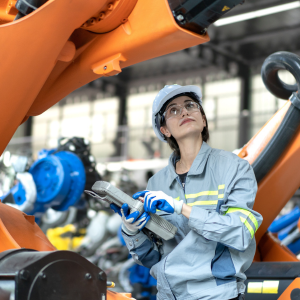2024 Manufacturing Trends
Post By: Holly Shaw On: 20-02-2024 - Industry 4.0 - Industry Trends - Manufacturing
Many of last year's trends are still prominent in manufacturing, especially regarding automation. Predictive maintenance and additive manufacturing (3D printing) continue to expand, while robots and digital twins are proving their worth in many industry sectors. Many businesses changed their working methods after the pandemic, with technological advances allowing more dispersed work sites. Businesses have become more agile, as the IIoT (Industrial Internet of Things) allows constant and instant responses to real-time situations.
Here at Rowse, we see the following manufacturing trends influencing the global industry landscape in 2024:
1. Increased Automation
The IIoT is the leading technological factor in Industry 4.0, which also deploys artificial intelligence (AI), machine learning (ML), big data and advanced analytics. At the beginning of 2020, only about 10% of manufacturers had implemented it, but this has advanced considerably since the pandemic. Some reports suggest that the adoption rate may now be as high as 85%, which will only get higher.
Virtually any sensor or device can now be connected to a network, offering high-speed manufacturing environments unprecedented flexibility. These systems generate vast amounts of data, spurring developments in communications technology. 5G wireless connectivity can achieve speeds up to 10 Gbps and near-zero latency, allowing more excellent, faster and more efficient connectivity.
2. Increased Efficiency With AI, ML And Advanced Analytics
The IIoT enables remote monitoring and focused manufacturing, producing and collecting vast data. For example, a typical oil rig may deploy over 80,000 sensors, providing a constant data flow. Information can be gathered from machinery and equipment status to real-time monitoring of process parameters (pressures, temperatures, flow rates, etc.). This data amounts to about two terabytes a day of information, hence its usual title of Big Data. This is far beyond the capacity of conventional data analysis methods, leading to the increased use of AI and ML in advanced analytics.
The automotive industry has adopted AI-based applications, with electronics, heavy machinery, metals and chemical industries not far behind. AI-based decision-making is applied in many areas, including production line checks, quality inspection, inventory control and supply chain management. ML and advanced analytics adoption is even more widespread since many manufacturing companies now recognise their contribution to significant revenue savings.
3. Reduced Errors With Digital Twins
Survey data suggests that almost 75% of companies in the advanced industrial sector have already begun using digital twins to aid decision-making. The leading sectors are aerospace and defence, but the energy, infrastructure and logistics sectors are also starting to explore it. Digital twins use scans and computer-aided design (CAD) to construct a 3D representation of almost any object, combined with virtual and augmented reality systems. This means designers and engineers can troubleshoot without requiring a physical model. Its applications include simulating and fixing potential design faults and predicting a product's viable lifespan based on a particular design. Companies like Siemens are already committing to an industrial metaverse that uses digital twins to optimise the operations and management of entire factories.
4. Reduced Downtime With Predictive Maintenance
We've often talked about the value of predictive maintenance, and the message is finally getting through. Equipment failures in the manufacturing environment can be extremely costly. Unplanned downtime can set manufacturers back up to £1.3 trillion a year. Predictive maintenance can help address this problem, reducing downtime by 30%-50%. Big Data analytics and the IIoT allow sophisticated algorithms to accurately predict equipment failures, increasing machine life by 20%-40%. More companies now recognise this, accelerating implementation by large-scale manufacturers.
5. Widespread Adoption of 3D Printing
3D printing or additive manufacturing has been a rapid growth industry. What started as an experimental bonus for manufacturers has become a legitimate, cost-effective and time-saving way to carry out various tasks. Large-scale 3D printing, short-run production, metal casting, and moulding are now feasible. For example, The new steel toolmaking process typically reduces costs by 50% and lead times by 80%.
Additive manufacturing is also highly prized for its capacity to produce one-off products like customised bike helmets and artificial limbs. There's a greater use of materials like thermoplastic polymers and carbon fibre. More companies are recognising the value of installing in-house 3D printers.
6. Emergence of Micro-Factories
The pandemic caused many manufacturers to change their production methods. Micro-factories are small, highly modular setups that use all the technological capacity of the IIoT to enable highly autonomous manufacturing. As a self-contained smart factory, these plants are incredibly flexible and resilient. They can affect small part runs, switch production lines rapidly to accommodate new designs and manage restructured supply chains. Micro-factories are a fraction of the size of traditional premises, cost much less and can be situated almost anywhere. Moving closer to the point of sale, time to market is reduced, and the entire system, from design to product despatch, is efficient and agile.
7. Increased Efficiency With Supply Chain Restructuring
The post-pandemic demand for resilience drives dramatic supply chain management and logistics shifts. Several factors have seriously affected the sourcing of raw materials and siting of production facilities. These include rising shipping costs, higher labour costs in previously cheap offshore countries, and increased social and regulatory pressures on sustainable sourcing. More companies are re-shoring as places like India, China, and Mexico have become more expensive manufacturing bases.
New strategies are also being used to source raw materials and components – sometimes described as local, near, or multi-sourcing. Again, 3D printing and AI-assisted supply chain and inventory management have helped manufacturers reduce their reliance on offshore sources. This has been underscored by shifts towards a circular economy and efforts to achieve net-zero emissions.
8. The Push Towards Carbon Neutrality
According to the latest available statistics, the manufacturing industry in the UK was responsible for producing almost 80 million metric tons of greenhouse gas emissions in 2021. This is 40% less than in 1990 but still accounts for around 17% of the UK's total GHG emissions. Globally, the manufacturing industry is responsible for 20% of all carbon emissions.
A worldwide push for sustainability has led to many countries adopting a net-zero emissions policy. There's a growing trend towards achieving carbon neutrality, reducing waste and adopting more sustainable practices. Companies are investing in renewable energies and transitioning to electric vehicles. Governments are offering funding incentives to the manufacturing sector to promote decarbonisation, like the UK's £1 billion Net Zero Innovation Portfolio.
9. Increased Threat of Cyber Attacks
Increased digitisation offers manufacturers great benefits, but it increases cybersecurity risks. Since 2022, the manufacturing sector has ranked above finance as the most targeted for ransomware attacks. It's suggested that at least half of the world's manufacturers consider cyber attacks as posing the biggest threat to their business. According to IT experts, this is due to the industry's low downtime tolerance, making it especially attractive to hackers.
Manufacturers must build cybersecurity into their systems when implementing digital transformation projects to prevent the potential exposure of sensitive and proprietary data. It's becoming an equal, if not greater, priority than the potential benefits of new technologies and ROI to protect systems and data against cyber threats. The cybersecurity preparedness of third-party supply chain participants is also critical to prevent disruption from a cyberattack.
10. Strategising to Combat Labour Shortages
Figures published by the UK government in November 2022 show that 13.3% of all surveyed businesses reported a labour shortage. Of these, manufacturing reported shortages of 12%. There were 1.19 million vacancies reported for September-November 2022, of which 84,000 were in manufacturing. Reasons for this include a post-pandemic change in attitude and engagement, changes in immigration and work policies after Brexit, declining birth rates and an ageing workforce.
This does not even touch on the subject of digitalisation. According to recent research, 36% or so of manufacturing vacancies are due to applicants not having the necessary skills, experience or qualifications to deal with the demands of new technology. This figure is about 12% higher than the average rate across all industries. One of 2024's most essential manufacturing trends will be finding a way to resolve this situation.
2024 And The Industrial Metaverse
Two thousand twenty-four manufacturing trends are all leaning towards intelligent automation and the IIOT, expanding predictive maintenance, 3D printing and AI-based decision-making with tools like big data analytics and digital twins. This adds up to the industrial metaverse of bright and micro-factories but carries increased threats of cyber attacks and labour shortages.
Get More From Rowse Straight To Your Inbox




